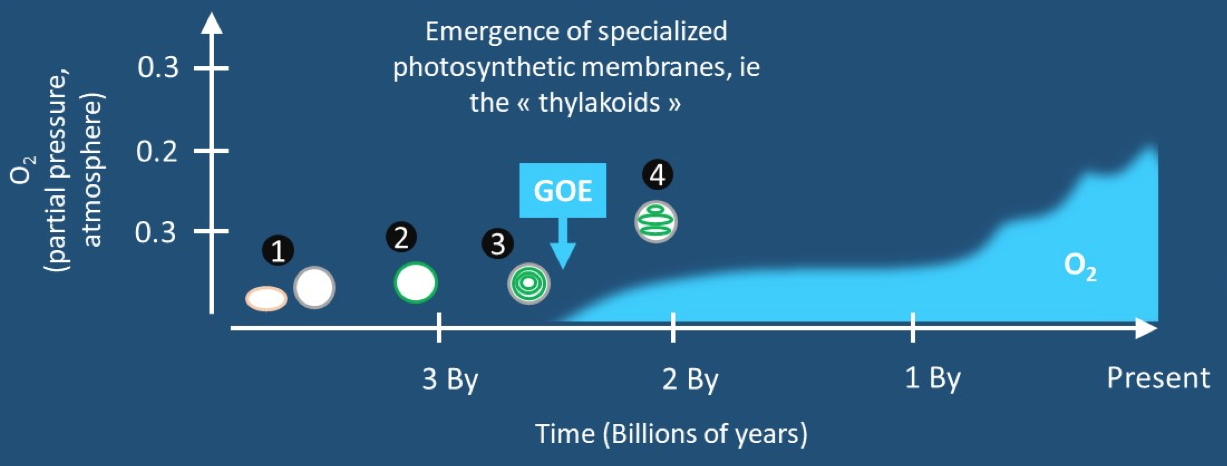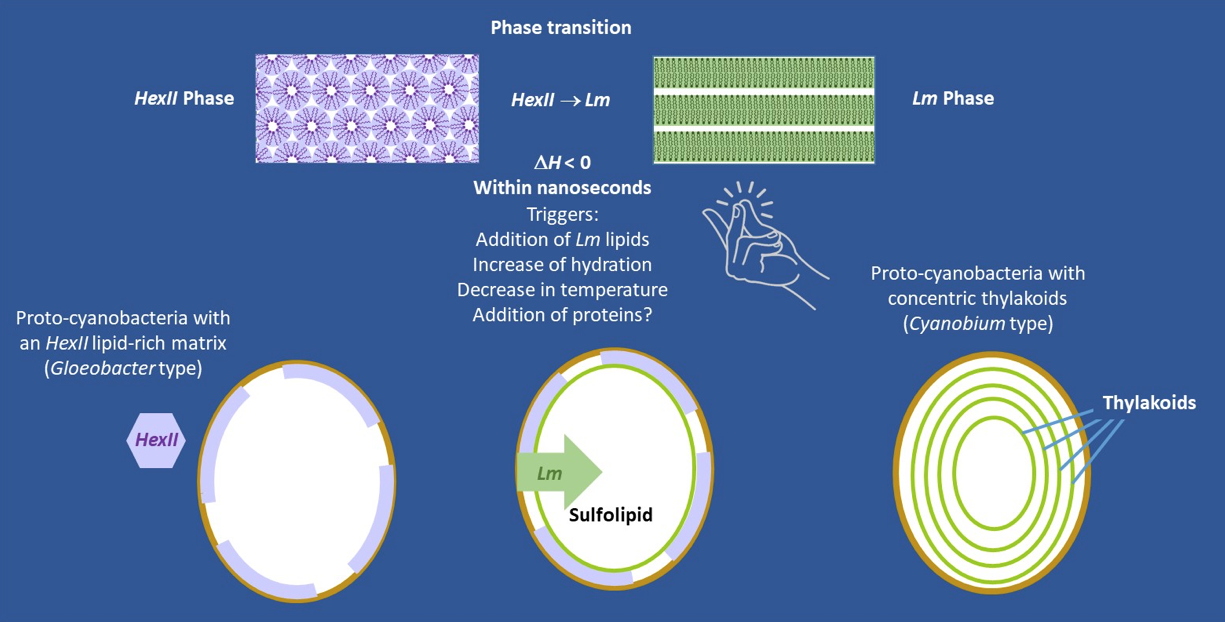About 4 billion years ago, different forms of life appeared on Earth in an environment deprived of dioxygen (O
2). They are at the origin of two of the three major "domains of life" still present on our planet, the "Archaea" and the "Bacteria" (
Figure 1, ①).
"Oxygenic photosynthesis" is a type of photosynthetic process that captures atmospheric CO
2 by combining hydrogen atoms obtained from ambient water, leading to the production of dioxygen. This release of O
2 had a major impact on the Earth, promoting the so-called "great oxygenation event" (GOE) about 2.4 billion years ago, the first step toward dioxygen loading of the Earth's atmosphere (
Figure 1, ③). Through reconstruction of protein evolution (molecular phylogeny) and examination of fossil rocks, it is estimated that oxygenic photosynthesis appeared in Bacteria at least 3 Billion years ago (
Figure 1, ②), at the root of the group of present-day cyanobacteria. In these primitive cyanobacteria (proto-cyanobacteria), thylakoids (intracellular membranes specialized for photosynthesis) were not yet present; photosystems (protein complexes capturing light energy) were inserted directly into cell-limiting membranes.
 Figure 1: Impact of photosynthetic organisms on the Earth's atmosphere. The appearance of primitive cell architectures is indicated, and photosynthetic membranes are schematized in green. "GOE": great oxygenation event or great oxidation event (appearance of dioxygen in the atmosphere).
Figure 1: Impact of photosynthetic organisms on the Earth's atmosphere. The appearance of primitive cell architectures is indicated, and photosynthetic membranes are schematized in green. "GOE": great oxygenation event or great oxidation event (appearance of dioxygen in the atmosphere).
At our laboratory, researchers evaluated the role of the emergence of thylakoids inside proto-cyanobacteria cells. They showed that these additional membranes increased the photosynthetic surface by introducing a multiplier effect consistent with a major impact on atmospheric oxygenation. However, should it be cyanobacteria or chloroplasts derived from them in the "Eukarya" domain of life, there is no known protein causing the "budding" of such intracellular membrane structures from peripheral membranes. The researchers then explored an alternative pathway that does not involve membrane budding but a simple transition between a phase comprising lipids that do not self-organize into membranes, but into a phase known as inverted hexagonal ("Hexagonal II" or
HexII phase), and a phase of stacked membranes ("Lamellar" or
Lm phase) (
Figure 2).
 Figure 2: An addition of Lm lipids (lamellar phase) to HexII lipids (hexagonal phase II) can generate membrane multilayers via a non-vesicular phase transition (thylakoid origin).
Figure 2: An addition of Lm lipids (lamellar phase) to HexII lipids (hexagonal phase II) can generate membrane multilayers via a non-vesicular phase transition (thylakoid origin).
The acquisition of the biosynthesis pathway of the sulfolipid sulfoquinovosyldiacylglycerol correlates with the emergence of thylakoids, allowing a sufficient supply of anionic
Lm lipids to trigger a
HexII ➛
Lm phase transition. With this non-vesicular lipid phase transition, a framework is also available to reexamine the role of companion proteins in nonconcentric thylakoid biogenesis (
Figure 1, ④). Consistently, non-vesicular biogenesis of thylakoids has been recently observed in present-day cyanobacteria.
This theory, which proposes a plausible answer to the emergence of thylakoids and GOE, has been selected to be part of the Darwin Reviews of Journal of Experimental Botany.